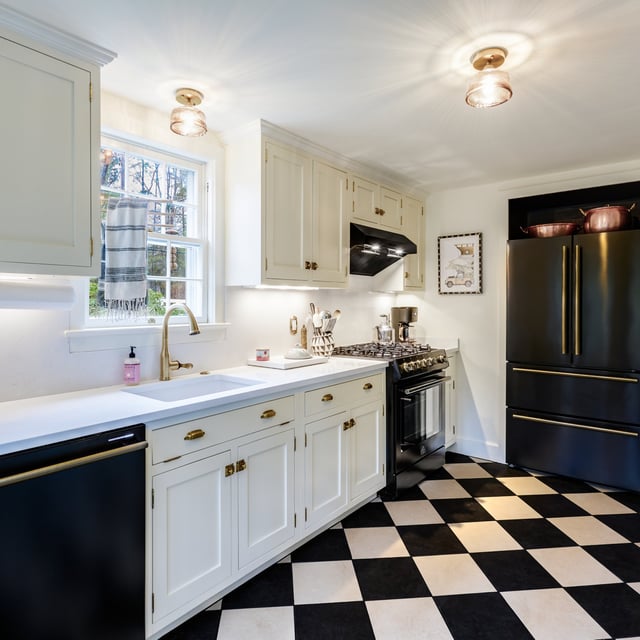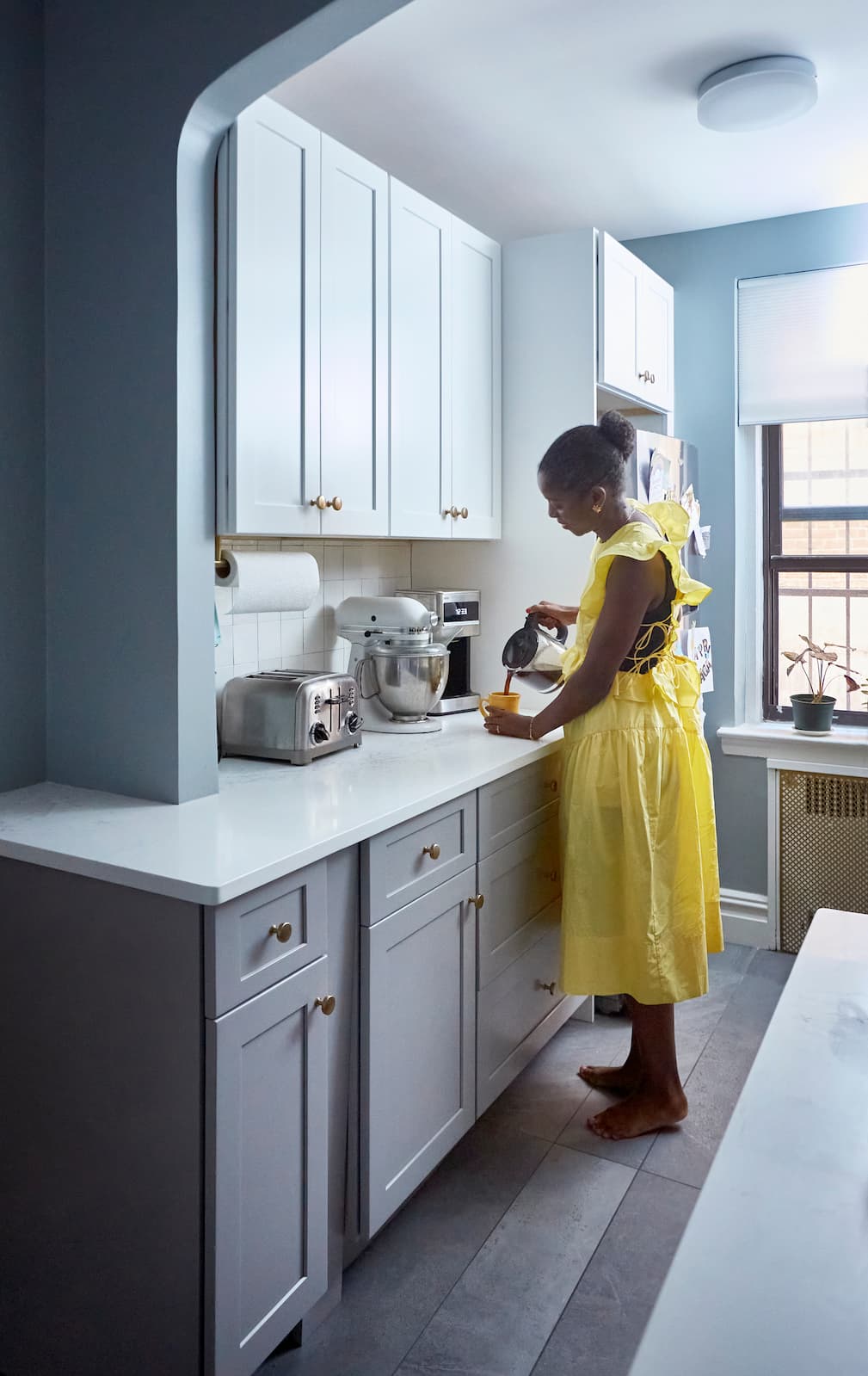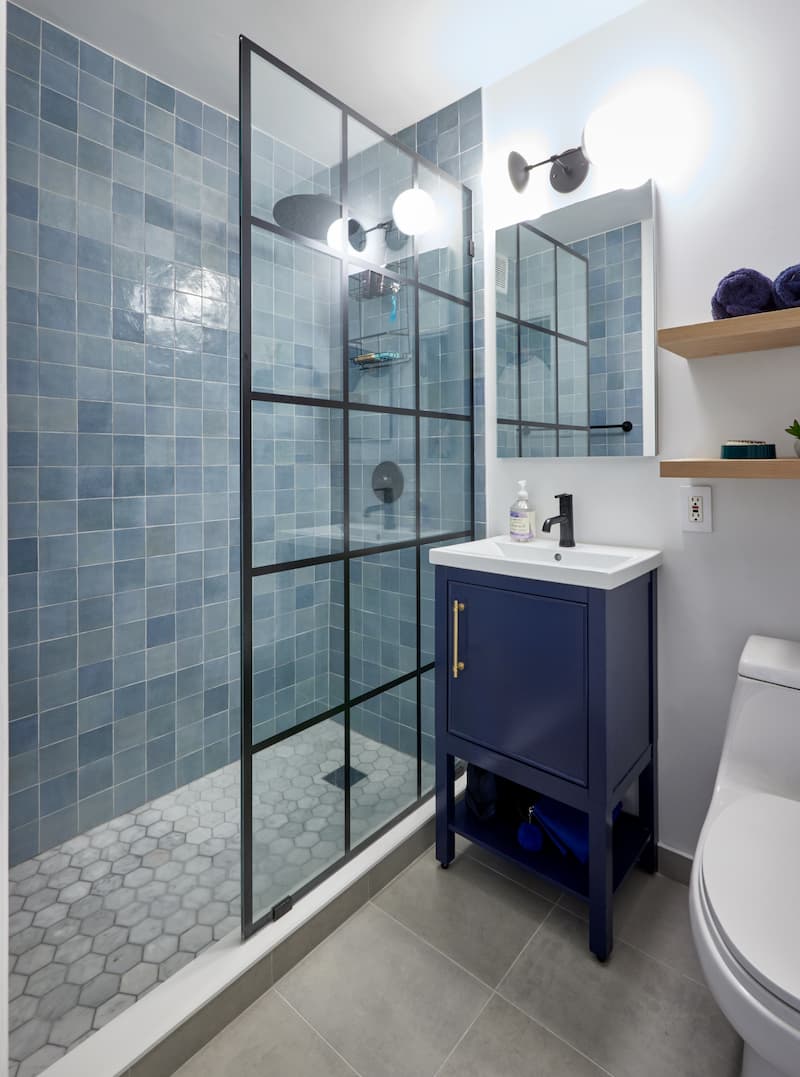Great Kitchen Configurations: Ideas to Transform Your Layout

In This Article
Your kitchen is more than just a place to cook—it’s the heart of your home, the hub of family gatherings, and the backdrop for countless memories. So, when it’s time to redesign, you want a layout that’s not only functional but also feels just right for your lifestyle. Ahead, explore great kitchen configurations, learn what to consider when making big changes, and get a few bonus tips to help you create the kitchen of your dreams.
Renovate with confidence every step of the way
Step 1: Personalize Your Renovation Plan
Step 2: Receive Quotes from Trusted Contractors
Step 3: Let Us Handle the Project Details

Reconfiguring Your Kitchen: Know Your Options
The Classic Galley Kitchen
A galley kitchen features two parallel countertops with a walkway in between. This layout is great for smaller homes or apartments because it maximizes efficiency in a compact space. With everything within arm’s reach, it’s a dream for serious cooks who value functionality.
However, galley kitchen configurations can feel a bit tight, especially when more than one person is trying to cook or move around. The lack of open space also means there’s no room for an island or dining area, so it’s best suited for homes where the kitchen is primarily a workspace.
The Open-Concept Kitchen
The open-concept kitchen is all about creating a seamless flow between the kitchen and adjacent living or dining areas. This layout is perfect for entertaining, as it allows you to cook while still engaging with guests or keeping an eye on the kids. The open design also makes the space feel larger and brighter.
Yet this popular kitchen configuration isn’t without its downsides. With fewer walls, you’ll need to get creative with storage solutions, and the lack of separation means your kitchen is always on display—so keeping it tidy becomes a priority.
The L-Shaped Kitchen
The L-shaped kitchen hugs two walls, forming an “L” shape that creates a natural work triangle between the sink, stove, and refrigerator. This layout is incredibly versatile and works well in both small and large spaces. It’s a great configuration if you want to leave room for a dining table or even an island.
However, the corner cabinets in an L-shaped kitchen can be tricky to access, so you’ll want to consider smart storage solutions like pull-out shelves or lazy Susans to make the most of the space.
The U-Shaped Kitchen
With countertops on three sides, the U-shaped kitchen is all about maximizing storage and workspace. This configuration is ideal for serious cooks who need plenty of room to spread out and keep everything organized. It’s also a great layout for families, as it provides ample counter space for multiple people to work at once.
Still, this particular layout may not be the best option for smaller homes, where a U-shaped kitchen can feel a bit closed off. 
The Island Kitchen
The island kitchen is a favorite for its versatility and functionality. Adding an island creates extra prep space, storage, and even seating, making it a great option for families and entertainers alike. Islands can also serve as a focal point, adding style and personality to your kitchen. However, this layout requires a lot of space to work effectively. If the island is too large or poorly placed, it can disrupt the flow of the kitchen and make it feel cramped.
The Peninsula Kitchen
A peninsula kitchen is similar to an island kitchen, but instead of a freestanding island, the peninsula is connected to a wall or countertop, creating a “G” shape. This layout offers many of the same benefits as an island, such as extra prep space and seating, but it’s a great option for kitchens that don’t have enough room for a full island. The connected design can also help define the kitchen area in an open-concept space. However, because the peninsula is attached, it can sometimes feel less flexible than a freestanding island.
The One-Wall Kitchen
The one-wall kitchen is the ultimate space-saver, with all appliances, cabinets, and countertops arranged along a single wall. This layout is common for New York studio kitchen or smaller homes where space is at a premium. It’s simple, streamlined, and efficient, making it a great choice for minimalist designs.
There’s no denying, the lack of counter space and storage can be a challenge, so it’s important to incorporate smart storage solutions like vertical shelving or multi-functional furniture to make the most of the space.
Compare Proposals with Ease

What to Know If You Want to Change Your Kitchen Layout
Changing the layout of your kitchen is more than a mere cosmetic update. You’re updating its very bones. This will naturally drive up the cost of your kitchen renovation. Elements that could be particularly impactful on your budget and timeline include:
Moving Plumbing or Gas Lines
Relocating your sink, dishwasher, or gas stove is one of the most significant expenses in a kitchen reconfiguration. These changes often require specialized work, such as rerouting water pipes, drainage systems, or gas lines, which can quickly add up. Additionally, moving plumbing or gas lines typically requires permits to ensure the work meets local building codes. This process can be time-consuming and requires professional expertise to avoid costly mistakes. If you’re considering moving these elements, it’s worth consulting with an interior designer or contractor early in the planning phase to understand the scope and cost of the work.
Electrical Work
Adding new outlets, rewiring for appliances, or upgrading your electrical system can be another major expense, especially in older homes. Modern kitchens often require more power to accommodate high-tech appliances, under-cabinet lighting, and other features. If your current electrical system isn’t equipped to handle the load, you may need to upgrade your circuit breaker or wiring, which can be a significant investment.
Additionally, adding outlets in new locations may require cutting into walls or cabinets, which can increase labor costs. While electrical work is essential for functionality, it’s important to factor these costs into your budget and prioritize safety by hiring a licensed electrician.
Structural Changes
Removing walls, adding new entry points, or expanding your kitchen space can dramatically change the look and feel of your layout—but these changes often come with a hefty price tag. Structural modifications may require reinforcements to ensure the stability of your home, especially if you’re dealing with load-bearing walls. For example, removing a wall to create an open-concept kitchen might require installing a beam to support the weight of the upper floors. Similarly, adding a new doorway or expanding the kitchen footprint may involve foundation work, which can be both costly and time-intensive. These changes may also typically require permits and inspections to ensure compliance with building codes.
Flooring Adjustments
If your reconfiguration involves moving walls, adding an island, or expanding the kitchen, you may need to update your flooring to match the new layout. This can be a hidden cost that catches homeowners off guard. For example, if you remove a wall, you’ll need to patch the flooring where the wall once stood, and if your current flooring is discontinued, you may need to replace the entire kitchen floor for a cohesive look. Flooring adjustments can range from simple fixes to full replacements, depending on the scope of your project.
Ventilation and Ductwork
Rearranging appliances like your stove or range hood may require changes to your ventilation system. Proper ventilation is essential for removing smoke, steam, and cooking odors, but moving ductwork can be a complex and costly process. If your new layout places the stove farther from an exterior wall, you may need to extend or reroute the ductwork, which can involve cutting into walls or ceilings. Alternatively, you might need to upgrade to a recirculating range hood, which doesn’t require external venting but may not be as effective. Ventilation is often overlooked during planning, so be sure to account for these costs when reconfiguring your kitchen.
Impactful Ideas to Upgrade Your Kitchen Layout
Remove a Wall or Turn It Into a Half-Wall
If your kitchen feels closed off or cramped, removing a wall can completely transform the space. By knocking down a wall, you can create an open-concept layout that connects your kitchen to the dining or living area, making it feel larger, brighter, and more inviting. This is especially beneficial for families or those who love to entertain, as it allows for better interaction between spaces.
If a full wall removal isn’t feasible—perhaps it’s load-bearing or you want to maintain some separation—consider turning it into a half-wall. A half-wall can still open up the space while providing a natural boundary between rooms. It’s also the perfect opportunity to add a breakfast bar or counter seating, creating a casual dining area where family and guests can gather while you cook. This small layout change can make your kitchen feel more social and functional without requiring a complete overhaul.
Add an Extra Entry Point
Does your kitchen feel like a dead end? Adding an extra entry point can improve traffic flow and make your kitchen feel more connected to the rest of your home. For example, if your kitchen is adjacent to another room, consider adding a doorway to create a circular flow between spaces. This is especially useful in homes with busy kitchens, as it prevents bottlenecks and makes it easier for multiple people to move around.
Another option is to turn a full counter into an island. By removing a section of cabinetry or countertop that blocks access, you can create a more open and flexible layout. This not only improves movement but also gives your kitchen a more modern and spacious feel.
Add (or Remove) a Kitchen Island or Peninsula
Kitchen islands and peninsulas are some of the most versatile features you can add to your layout. A well-placed island can serve as a prep station, dining area, storage hub, or even a homework spot for kids. It’s a great way to add functionality and style to your kitchen, especially if you have the space to accommodate one. You can customize your island with features like a built-in sink, extra outlets, or open shelving to suit your specific needs.
If your kitchen is on the smaller side, a peninsula might be a better option. Peninsulas offer many of the same benefits as islands but take up less space since they’re connected to a wall or countertop. They’re ideal for creating a natural division between the kitchen and adjacent spaces, like a dining or living room.
On the flip side, if your current island or peninsula feels like it’s in the way, don’t be afraid to remove it or rethink its function. For example, a bulky island might be replaced with a smaller, more streamlined version, or a peninsula could be converted into a freestanding island to improve flow. The key is to ensure that these features enhance your kitchen’s usability rather than hindering it.
Create a Dedicated Pantry Space
If you’re constantly running out of storage, consider carving out space for a dedicated pantry. This could mean converting a small closet near the kitchen into a walk-in pantry or adding a built-in pantry cabinet to your layout. A pantry not only keeps your dry goods organized but also frees up valuable cabinet space for other essentials. If space is tight, you can even incorporate a pull-out pantry into your cabinetry for a sleek, space-saving solution.
Install a Double Island
For larger kitchens, a double island layout can take functionality to the next level. One island can be dedicated to food prep, with a sink and plenty of counter space, while the other can serve as a dining area, homework station, or buffet for entertaining. This setup is ideal for families or those who love to host, as it provides ample space for multiple activities without crowding the kitchen.
Incorporate a Multi-Functional Dining Nook
If you have the space, consider adding a cozy dining nook to your kitchen. A built-in bench with a table can double as a casual dining area and extra storage, with drawers or cabinets built into the bench. This is a great way to make use of an underutilized corner or awkward space while creating a warm, inviting spot for family meals or morning coffee.
Turn your renovation vision into reality
Get matched with trusted contractors and start your renovation today!
Find a Contractor
Bonus Tips for Designing the Perfect Kitchen Layout
- Make walkways no narrower than 3 feet. This will allow for easy movement, even when multiple people are in the kitchen. If your kitchen is a high-traffic area, consider widening walkways to 4 feet for added comfort and accessibility.
- Don’t crowd appliances. Ensure there’s enough space around appliances for proper functionality and safety. For example, your refrigerator door should open fully without blocking a walkway, and your oven shouldn’t be placed too close to seating areas or walls.
- Customize storage solutions to your family’s needs. Tailor your storage to fit your lifestyle. Deep drawers for baking supplies, pull-out shelves for pots and pans, or a dedicated snack cabinet for kids can make your kitchen more functional and organized.
- The more electrical outlets, the better. Modern kitchens require plenty of outlets for appliances, gadgets, and chargers. Add outlets along the backsplash, on the island, and even inside cabinets for hidden appliances, and consider USB outlets for added convenience.
- Plan for trash and recycling. Keep trash and recycling bins out of sight with pull-out cabinets near the sink or prep area. If you compost, include a dedicated bin for food scraps to make cleanup more efficient.
- Think about ventilation. A high-quality range hood is essential for removing smoke, steam, and odors. Choose a hood with the right balance of power and noise level, or opt for a recirculating hood with a charcoal filter if external venting isn’t possible
Alternative Ways to Revamp Your Kitchen Without Changing the Layout
- Switch from opaque cabinets to doorless designs. Glass shelving or cabinets without doors can make your kitchen feel more spacious and modern. Plus, it’s a great excuse to show off your favorite dishes or glassware.
- Upgrade your appliances. Sometimes, a sleek new fridge or a high-tech oven is all it takes to breathe new life into your kitchen.
- Don’t skimp on good lighting. Layered lighting—like under-cabinet lights, pendant fixtures, and recessed lighting—can completely transform the look and feel of your kitchen, all the while making a decorative statement.
- Add a bold backsplash. A colorful or textured backsplash can add personality and style to your kitchen without requiring a major overhaul.
- Refresh your hardware. Swapping out cabinet handles, drawer pulls, and faucets is a quick and affordable way to give your kitchen a fresh, updated look.
For more inspiration, check out Stylish and Practical Small Kitchen Remodel Ideas.
Ready for the Next Step in Reconfiguring Your Kitchen? Talk to a Design Specialist With Block Renovation
At Block Renovation, we specialize in creating kitchens that are tailored to your home and lifestyle. Our team includes interior designers and contractors who understand the ins and outs of renovating homes like yours—whether you live in a historic brownstone, a compact apartment, or a row home. By listening to your vision and guiding you every step of the way, we ensure your new layout reflects your unique needs and style. You can even see before-and-after photos of our kitchen projects.
Best of all, we make home renovations as stress-free as possible by providing expert guidance, clear communication, and access to vetted professionals who bring your vision to life. Our Renovation Planner lets you visualize your new kitchen layout and understand how every decision impacts your budget, so you can plan with confidence.
With safeguards like expert scope reviews and a secure payment system, we protect your investment and keep your project on track. Choosing Block means creating a kitchen that’s not just functional, but a true reflection of the life you love.

Written by Block Renovation

Renovate confidently with Block
Easily compare quotes from top quality contractors, and get peace of mind with warranty & price protections.
Thousands of homeowners have renovated with Block

4.5 Stars (100+)

4.7 Stars (100+)

4.5 Stars (75+)
Renovate confidently
- Top quality contractors
- Warranty & price protections
- Expert resources

